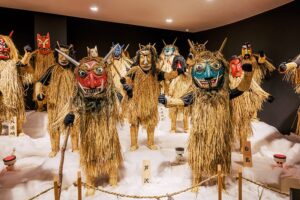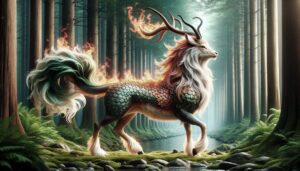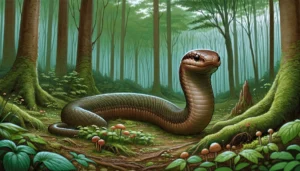Table of Contents

The Kitsune, renowned for their magic, immortality, and irresistible charm, have enchanted the Japanese people for centuries. These legendary foxes are more than just adorable creatures; they embody a complex blend of mystique and wonder. Let’s delve into the fascinating world of the Kitsune, exploring their characteristics, personalities, special abilities, and cultural significance.
Origin
The origin of Kitsune can be traced back to ancient Chinese mythology, where tales of magical, nine-tailed foxes known as “huli jing” first captivated imaginations. These enigmatic creatures were believed to possess extraordinary powers, including the ability to shapeshift, manipulate their surroundings, and wield psychic abilities.
As these stories traveled across borders and time, they found their way into Japanese culture, where the Kitsune would go on to become an integral part of folklore and mythology. In the eighth century, Kitsune made their literary debut in Japan, and their legend has continued to thrive ever since.
Japanese storytellers and artists were quick to embrace the captivating allure of these mystical foxes. Kitsune found their place as statues in ancient shrines dedicated to Inari, the goddess of rice and prosperity, symbolizing their connection to wealth and well-being. In Japanese calligraphy scrolls and countless folktales, Kitsune left their indelible mark.
Belief in Kitsune’s magical abilities persisted well into the eighteenth century, shaping cultural practices and societal beliefs. Special tofu recipes were crafted as offerings to the foxes believed to reside around Inari’s temples. Some families even kept foxes as pets, entrusting them with the promise of bringing prosperity and success.
However, not all interactions with Kitsune were benevolent. Some families were believed to be descended from yako foxes, the mischievous and sometimes destructive counterparts to the benevolent zenko. In cases of mental illness, it was common to attribute the condition to “kitsunetsuki,” or possession by foxes, further entrenching Kitsune in the collective consciousness.
Characteristics

Physical Description: At birth, Kitsunes resemble ordinary foxes, but they gradually acquire their magical appearance and powers over time. Every century, a Kitsune grows a new tail, with a maximum of nine tails. As they age, their red fur may transform into gold and eventually white. Upon reaching their one hundredth birthday, they gain the ability to shapeshift into various forms, often choosing those that command respect, such as an elegant young woman or a wise old priest.
Personality: Kitsunes possess extraordinary intelligence and boundless creativity, making them unpredictable and complex beings. They can be broadly categorized into two groups: zenko and yako. Zenko are benevolent foxes who serve Inari, the goddess of rice and prosperity. They offer wisdom to humans, become guardians of households, and resolve disputes in favor of humans. In contrast, yako are mischievous and sometimes destructive, targeting arrogant or lazy individuals. Many Kitsune, regardless of alignment, exhibit a romantic streak, often intermarrying with humans.
Special Abilities
Kitsune’s Illusions: Kitsune are masters of illusion. Shapeshifting is just the tip of the iceberg. They can transform their surroundings, conjuring luxurious mansions in graveyards and creating fleeting wealth that turns into grass by dawn. They can spend years in human form without detection.
Psychic Powers: Kitsune possess psychic abilities, enabling them to enter human bodies for various purposes, from humiliation to delivering messages through dreams.
Other Powers: Kitsune have a wide range of miscellaneous powers, including flight, fire-breathing, weather manipulation, and glimpses into the future.
Cultural Representation
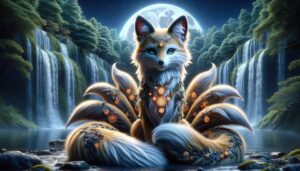
Origin: The Kitsune’s origins can be traced back to Chinese tales of nine-tailed foxes known as huli jing. In Japanese culture, Kitsune made their literary debut in the eighth century and have remained a prominent fixture ever since.
Historical Beliefs: Japanese people believed in the magical prowess of Kitsune until the eighteenth century. Special tofu recipes were created as offerings to foxes, and some families even kept foxes as pets, hoping for wealth and success. Cases of mental illness were attributed to “kitsunetsuki,” or possession by foxes.
Modern Appearances: Kitsune continue to captivate modern culture, especially in visual entertainment like comics, anime, and video games. They appear in popular titles such as Naruto, Pokémon, Animal Crossing, Zelda, and Mario, keeping their enchanting legacy alive and well in the contemporary world.
Myths and Stories
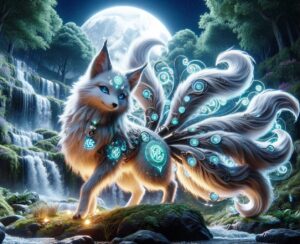
In one mesmerizing story, a Kitsune’s transformation into a beautiful woman serves as the focal point. In this tale, the Kitsune assumes a human guise, exuding grace and allure. With this captivating façade, she marries a human, thus entering the world of mortals. Her union with a human brings not only love but also prosperity to the family. The Kitsune’s magical charm bestows upon the household newfound wealth, symbolizing the benevolent aspect of these mystical creatures.
In another equally captivating narrative, the Kitsune’s mischievous tendencies come to the forefront. In this tale, a nobleman with an inflated ego becomes the unwitting target of the Kitsune’s pranks. The Kitsune, fueled by a desire to humble the arrogant nobleman, devises a series of cunning tricks and illusions. These playful antics ultimately culminate in the humiliation of the haughty nobleman, leaving him stripped of his arrogance. This story embodies the mischievous side of Kitsune, as they take delight in toying with human foibles.
These two tales, like many others in Japanese folklore, serve as poignant reminders of the Kitsune’s multifaceted nature. Their stories traverse the spectrum of human emotions, showcasing the Kitsune’s ability to both uplift and confound, to enchant and bewilder. It is this very duality that continues to make Kitsune an enduring and captivating presence in the rich cultural tapestry of Japan, ensuring that their allure remains as potent as ever in the hearts and minds of those who hear their tales.
The Kitsune’s enduring presence in Japanese culture and folklore serves as a testament to their enduring allure, capturing the hearts and imaginations of people both in Japan and beyond for generations.
FAQ
How do Kitsune transform?
Kitsune gain shapeshifting abilities as they age, often assuming human forms or other shapes.
Are Kitsune good or mischievous?
Kitsune can be both. Some are benevolent (zenko), while others are mischievous or even malevolent (yako).
What are Kitsune's special powers?
Kitsune possess powers of illusion, psychic abilities, and various other magical talents, such as flying and fire-breathing.
How are Kitsune represented in Japanese culture?
Kitsune are featured in ancient shrines, calligraphy scrolls, and continue to appear in modern media like anime and video games.
Are there any famous Kitsune myths?
Yes, there are numerous tales featuring Kitsune, from marriages to pranks, showcasing their dual nature.

